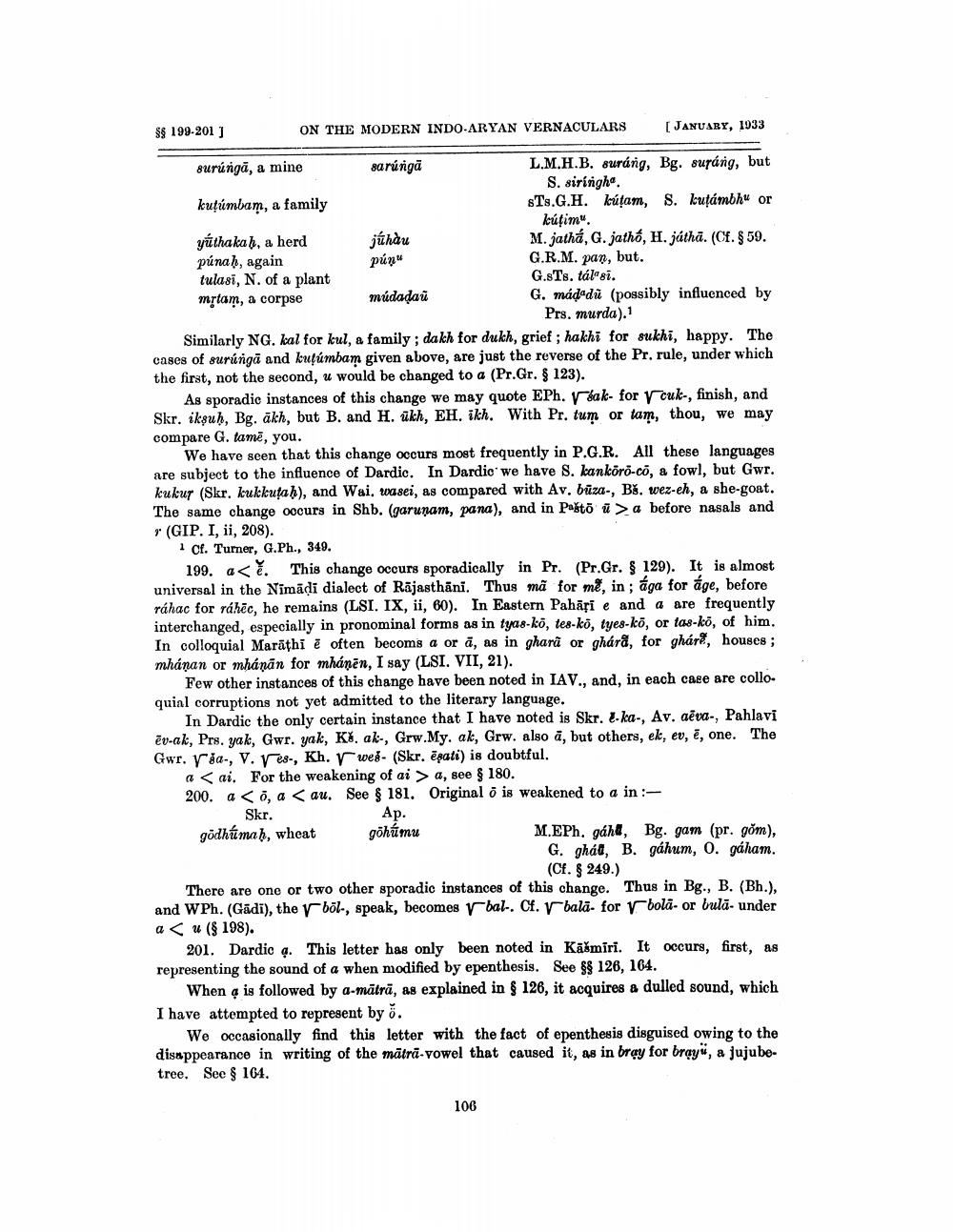________________
$$ 199-2013
ON THE MODERN INDO-ARYAN VERNACULARS
[JANUARY, 1033
púnu
surúngā, a mine
sarúngā
L.M.H.B. suráng, Bg. suráng, but
S. siringhe. kutumbam, a family
sTs.G.H. kútam, S. kuțámbhu or
kútim". yúthakah, a herd júhàu
M. jathá, G. jathó, H. játha. (Cf. $59. púnah, again
G.R.M. pan, but. tulasi, N. of a plant
G.sTs, tálasi. mrtam, a corpse múdadaŭ
G. mádedů (possibly influenced by
Prs. murda). Similarly NG.kal for kul, a family; dakh for dukh, grief; hakhi for sukhi, happy. The cases of surúngā and kutumbam given above, are just the reverse of the Pr, rule, under which the first, not the second, u would be changed to a (Pr.Gr. 123).
As sporadic instances of this change we may quote Eph. V dak- for v cuk-, finish, and Skr. ikṣuḥ, Bg. ākh, but B. and H. ūkh, EH, ikh. With Pr. tum or tam, thou, we may compare G. tamē, you.
We have seen that this change occurs most frequently in P.G.R. All these languages are subject to the influence of Dardic. In Dardic we have S. kankoro-co, a fowl, but Gwr. kukur (Skr. kulkutah), and Wai. wasei, as compared with Av. būza-, Bx. wez-eh, a she-goat. The same change oocurs in Shb. (garunam, pana), and in Pašto ū> a before nasals and (GIP. I, ii, 208).
cf. Turner, G.Ph., 349.
199. a< . This change occurs sporadically in Pr. (Pr. Gr. $ 129). It is almost universal in the Nimadi dialect of Rājasthāni. Thus mã for me, in ; ága for áge, before ráhac for ráhēc, he remains (LSI. IX, ii, 60). In Eastern Pahāți e and a are frequently interchanged, especially in pronominal forms as in tyas-kő, tes-kö, tyes-kő, or tas-kő, of him. In colloquial Marāthi è often becoms a or ā, as in gharà or ghárå, for gháre, houses; mhanan or mhánān for mhánen, I say (LSI. VII, 21).
Few other instances of this change have been noted in IAV., and, in each case are colloquial corruptions not yet admitted to the literary language.
In Dardic the only certain instance that I have noted is Skr. 2.ka, Av. aēva-, Pahlavi ēv-ak, Prs.yak, Gwr. yak, Kť, ak-, Grw.My. ak, Grw. also ā, but others, ek, ev, ē, one. The Gwr. Via, V. Ves, Kh. r weg- (Skr, épati) is doubtful.
a < ai. For the weakening of ai > a, see § 180. 200. a<7, a <au. See $ 181. Original o is weakened to a in:Skr.
Ap. gödhímah, wheat göhúmu
M.EPh. gáhl, Bg. gam (pr. göm),
G. ghát, B. gáhum, 0. gáham.
(Cf. & 249.) There are one or two other sporadic instances of this change. Thus in Bg., B. (Bh.), and WPh. (Gādī), the r böl-, speak, becomes bal. Cf. r bala- for r bola- or bulā- under
u (f 198).
201. Dardic a. This letter has only been noted in Kāšmiri. It occurs, first, as representing the sound of a when modified by epenthesis. See && 126, 164.
When a is followed by a mätrā, as explained in $ 126, it acquires a dulled sound, which I have attempted to represent by ö.
We occasionally find this letter with the fact of epenthesis disguised owing to the disappearance in writing of the mātrā-vowel that caused it, as in bray for brøy, a jujubetree. See § 164.
a
106




